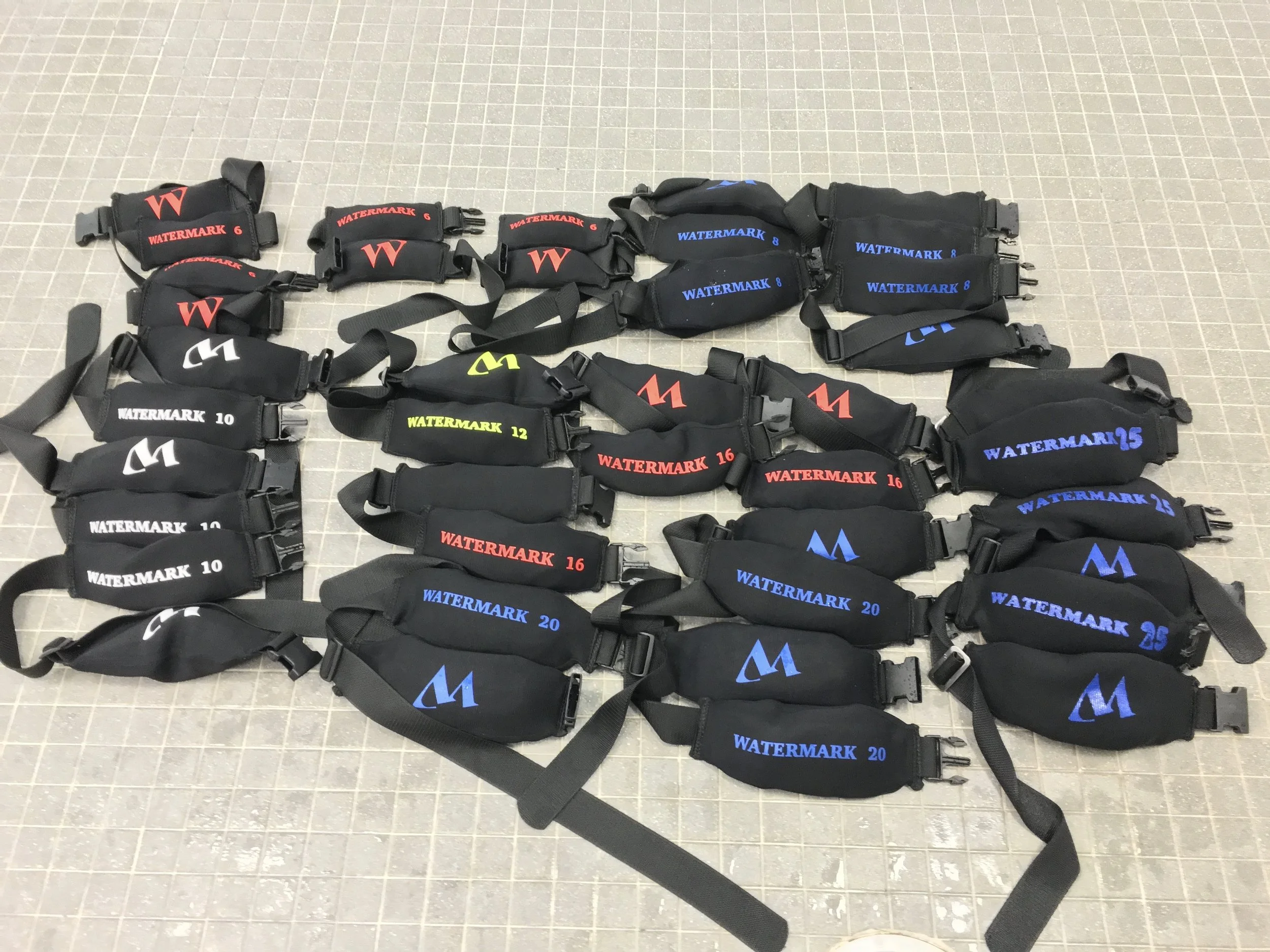The Correct Way to Train with Weight Belts For Swimming
On weight belts and so forth…
I remember straining my eyes, peering closely, bewildered, my mind unable to comprehend what my senses told me. Was it weight plates attached to a belt...no...it couldn’t be...a belt with actual weight plates? Yes, it certainly was, indeed. And the weights attached to the belt; the belt made its way around the boy’s waist. And yes, weight plates better suited for a home gym adorned the belt. Engaged in an activity we’ll loosely consider swimming, it was all the poor lad could do to stay afloat, this spectacle of schoolyard tomfoolery no fault of his own. This was weight belt training for our sport, they said.
Scandals aside, I don’t recall a time I’ve ever been more embarrassed for the profession of swimming coach. A belt with plates. A stack of plates found in your garage gym and so forth. I was dumbfounded watching it, and a part of me is still confused months later. I waited to write this article for a good reason; I didn’t think it good taste to write when the story was fresh; folks were heated (rightly so), and my two cents would have added more insult to injury and created more controversy than necessary.
Reexploring it now shouldn't have the same effect, and my guess is that it’s old news, the proverbial water under the bridge and so forth. I do hope the coach can recover and move on in his career; He isn’t the first coach to make a bad decision, and he won’t be the last. I’m sure some current elite-level types made a few blunders in their early days. But a makeshift belt with weight plates? A fanny-pack or two filled with rocks would have been better, perhaps genius in comparison. Good heavens.
If the above news story referenced was your first introduction to weight belt training, I must apologize sincerely, and please allow me to offer an alternative in my defense of the belts. My goal today is not to tear down the aforementioned coach further; I aim to provide education for those looking to try belts and show the masses that there is a way to use them intelligently. I’ll describe how we train here at Liberty; I can assure you the protocol is much different, the results, night and day.
As my thoughts in this article defend the use of weight belts in training, I invite open-minded thinkers to re-examine what is considered “too heavy” concerning their use. Question the assumption that eight, ten, or fifteen pounds are heavy. Is it too heavy? How do we know? How can we be sure? What evidence do we have? What mental models do we have? What if there were an alternative belief? What of progressive overload and adaptation? Heavy is relative - what is a heavy hang clean for a novice freshman in the weight room might be the warmup for a senior. Does the same concept apply to Power Towers and weight belts?
I wrote extensively about weight belts in my Power Training book, and similar to Sam Freas who popularized their use, I do believe weight belts are a valuable tool for training in general, and sprinting specifically. Here at Liberty, we use belts with everyone, from the 50 to the 1650, 400 IM, and everywhere in-between. As it were, prior to the mid-season suit meets, we had the fastest times in our conference in the 50, 1000, and 400 IM (we don’t suit for our mid-season meet). Causation and correlation - yes, yes, I know, that is just to say, we believe in the belts and use them frequently.
As for how we use weight belts here at LU, allow me the liberty to properly educate the young coaches reading (this article is really all for you) and to provide hope for the experts - hope that yes, there are programs that use belts intelligently and that not all is lost.
1. First and foremost, it is imperative for coaches to develop a mental model of elite-level training in general, and specifically for their training tool of choice
The use of high-level mental models in coaching is essential, to say the least. See Peak and other books on the neuroscience of elite performance and coaching. If you’ve never witnessed world-class, it is hard to develop a mental model to evaluate and coach such things.
Two seconds into the “weight belt” (it was no such thing) weight stack video, I knew we were in for quite the debacle. I’ve developed a sound mental model over the years of what elite-level training with a belt “looks” and “feels” like, and I know how it should play out in the water. The same can be said for Power Towers and what have you; I was fortunate to develop models for these devices early in my career while at Penn State and Arizona, and saw world record holders and Olympic Gold Medalists display their skills on such tools daily. The mental model of how it should look is engrained in me (see Blink by Malcolm Gladwell and the story of the Greek Statues specifically).
Had this coach developed a sound mental model for how a proper weight belt swim should look, he would have known to shut it down well before what we saw in the video, and better yet, he wouldn’t have tried in the first place. If you want to be elite-level, you must develop elite-level mental models, whether for Power Towers, weight belts, T-3000’s, Race Pace repeats, or any other type of training.
2. The type of weight belt matters
It’s essential, to say the absolute very least. One can get away with a variety of drag force resisted equipment...we have Power Towers, Power Racks, parachutes, stretch cords, the Pinnacle Pulley System, DIY jobs, we can pull buckets on a string, tow people on the ankles, ad infinitum. Training drag force is easy - swim against a horizontal resistance. If you stop, you stop, nothing happens, and the world is all as it should be.
Weight belts, on the other hand, are inherently more dangerous, for obvious reasons, and you simply can’t just strap on any old “weight belt” and think you’re good to go. You must have the right kind of weight belt, namely these characteristics:
Easy OFF clipping mechanism (this is the most important quality in a weight belt)
Enclosed weight
Balanced weight
Made for the water
Both Sam Freas and I recommend the Watermark Pro weight belts, and while initially made for SCUBA, they’ve branched out to market to the swimming community specifically, even shipping a booklet of swim set examples when you purchase the belts (my Power Tower book sets are far better, but I could be biased). There is no better weight belt for swimming, and the Watermark belts should be the go-to belt for any coach looking to add belts to their training arsenal. There are others, but none beat a Watermark as of December of 2018.
3. Think of weight belt training as though an exercise in the weight room
In reality, that’s what it is. And that is the beauty of the training; in-water resistance work is the bridge that spans the gap between land strength (weight room) and specific power/force application in the water (pure speed). I am a firm believer that yes, in-water resistance training is this missing link; it is part weight room, part water, but not 100% weight room nor 100% water.
A weight belt is an excellent tool in this regard, offering both drag and lift force resistance, and swimmers must maximize the strength, power, efficiency, and force application of the stroke, kick, and body position to overcome said resistance. And that’s just the physics, let us not forget the metabolic training effects of the weight belt as well. Of note: There is an area prime for research...what are the metabolic effects of belts in training? My senses and watch tell me it is strong, indeed, but thus far the majority of feedback from our women merely is that it’s “harder.” The belts are also great for working core strength and core endurance, as well as starts and turns. For an in-depth look, see the Power Tower book, as my goal with this article is more the how and not the why.
The weight belts are now diamond..trap bars! Or weighted core bridges, squats, cleans, etc.. Weight belt swimming is now an exercise in the weight room. From this point forward and for all-time you must think of it as such. A different frame of reference and asking different questions produces different results, as we shall see. Think now in terms of sets, reps, loads, time under tension, the rate of force development, etc.. You must set aside time intervals and “N” number of repeats. We’ll come back to it later, but for now, think of weight belts ONLY in terms of a single lift in the weight room.
Now, imagine you have an athlete with no experience whatsoever in the weight room. Perhaps you read my article on strength training for high school swimmers and started her on basic movement patterns- so far so good. You might even go some squats with just the bar, maybe some deadlifts with 65 pounds if she displays excellent technique and comes from a solid base dryland program.
But what you wouldn’t do, I hope, is load her up with something heavy the first time she tries a specific lift. And what you wouldn’t do, I hope, is load her up with something heavy the first time she tries weight belts. Progressive overload is critical, whether in the weight room or in the pool with towers and belts.
If you’re keeping track, note that here at LU we’re starting from a MUCH different reference point and frame of mind before prescribing a single weight belt effort. We have mental models of elite-level training, we have the right weight belts, and we’re approaching the belts with a weight room mentality in regards to sets, reps, loads, etc.. I don’t want to say that the rest is easy, but we’ve certainly started from a point that makes training with belts similar to any other protocol. Much like the weight room, progressive overload, sound programming, and attention to detail can now carry us as far as the athlete’s skill, strength, and overall genetic potential allow us to go.
There is a point of diminishing returns, yes, but its not eight pounds, nor is it 15. We have women here at Liberty who can deadlift over 400 pounds, and I can assure you that with the proper programming mentioned above, they can and do build up to using 15-pound belts and more. Just as in the weight room, heavy is relative.
As for specific programming and training, keep in mind that we approach the following thoughts with a firm foundation in the aforementioned three principles.
1. We start our freshmen with 6-pound belts
This is one of the lightest Watermark belts you can buy and provides a great starting point for Division I-level women with a solid club background. They may or may not have weight room experience. We consider the bar in the weight room (45 pounds) a 6-pound weight belt. Your average high-schooler probably uses a backpack much heavier, and while yes, a weight belt in the water is different, such an analogy provides a stable reference point for starting weight belt work in the water.
2. We progress the load based on adaptation, strength, confidence, desire, and general season planning
Again consider the weight room, where one can progress somewhat quickly when the initial gains are mainly neuromuscular, and the brain is learning how to perform the activity. We see the same with the belts, and much of the early gains, from 6 to 10 pounds, for example, is the neuromuscular system learning how to find more leverage on the water and directing the appropriate motor unit response.
And as in the weight room, desire and confidence go a long way. If you are training an athlete on land, who doesn’t particularly want to lift heavy and has little faith in doing so, good luck in getting him stronger. If you have an athlete who embraces the challenge of belts, desires to improve, and approaches the “lifts” with extreme focus, just as in the weight room, impressive strength gains are indeed possible.
3. We use belts for more than just Pure Power
12.5’s on long rest are fun, and we do quite a few of them with our entire team here at Liberty. But as with the Power Towers, 12.5’s aren’t everything, and the belts are great for race pace training, kicking, drilling, and dive quality work as well. Check out this article for some Arizona Drill with weight belts and some ideas on how we incorporate drilling with resistance into our program here at LU.
4. We go heavy
I can assure you that 15 pounds is not the limit. I love Sam Freas, and his Sprinting: A Coaches Challenge was the first swimming book I bought as a young coach. I am proud to say I still have my original copy! However, I have to disagree with him here, as he doesn’t allow his athletes to go above 15 pounds, even for elite-level college men.
As we know, heavy is relative and is entirely athlete dependent. Again think weight room and the incredible differences we see in strength and power between athletes - freshmen vs. seniors, for example. We went heavier than 15 pounds with college men as far back as 2006 during my days as the sprint coach at Penn State; We now have women here at Liberty who handle more than 15 pounds with ease on a regular basis.
Progressive adaptation is a beautiful thing, and again, if women can build up to deadlifting more than 400 pounds, they certainly can build up to some impressive numbers as far as weight belts are concerned. Let me repeat again, ad nauseam, that the Watermark Pro belts with the quick release buckle, made specifically for swimming, are the only belts on which I would let an athlete go heavy.
For an in-depth look at a Power Workout featuring heavy belts, check out this article, highlighting some running dive efforts with a 25-pound belt from or Florida training trip a few years back. This is real weight belt training, and as you can see it looks nothing like what we saw in the weight plate video.
5. Logic and reason rules ego
Simply put, we know when to shut it down, and again the idea of mental models is essential. I know right where that point is that we need to stop and stop we do. This is an important skill to learn for all coaches, in all sports, perhaps more so swimming coaches and in weight belt or Power Tower training specifically.
Conclusion
If you gave up on weight belts after the video that started this post, perhaps I’ve at least convinced you to reexamine their efficacy and value in training. Maybe you’ll try them again for the first time. If nothing else, perhaps you will look more favorably on coaches who do use them correctly. To those young coaches just starting out, this article is for you. No more weight plate stacks, please. Reread these words 10 times or so before using belts. Take notes. Watch the videos. Develop mental models of elite athletes using belts in training...
HINT: it looks NOTHING like what we saw in the video!
Go out and see weight belts in action. We’ve had many visitors to our program over the years, and with our new pool completely finished, there’s even more reason to come. You are welcome anytime, and we would be happy to have you.



